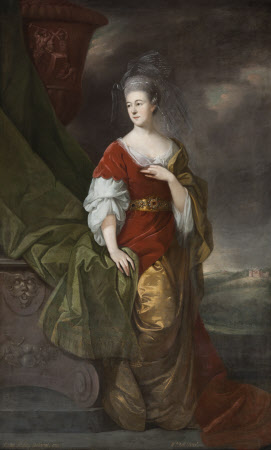Susanna Robinson, Lady Delaval (1730 - 1783), as Venus, beside an urn on a pedestal, in a landscape setting
William Bell (c.1735 - 1794)
Category
Art / Oil paintings
Date
1770 (signed and bears date)
Materials
Oil on canvas
Measurements
2362 x 1448 mm (93 x 57 in)
Place of origin
England
Order this imageCollection
Seaton Delaval Hall, Northumberland
NT 1276760
Caption
This portrait is one of a series, depicting Delaval family members, which now hang in the Gallery at Seaton Delaval. The sitter was the daughter of Ralph Robinson of Gateshead and Margaret Delaval. She married John Potter, but was widowed and became the first wife of John, Lord Delaval in 1750. She is here shown as Venus, the goddess of love, wearing the appropriate red and white dress, and the belt around ‘Venus’s zone’. The forge of Vulcan has been depicted on the urn. Vulcan was Venus’s husband, who made a set of armour for her son, Aeneas, who was about to go to war in Latium. The urn rises into a pinnacle like those on Vanbrugh’s skyline of Seaton Delaval. For most of his life, William Bell was a provincial painter in Newcastle-upon-Tyne. This series of portraits is undoubtedly his masterpiece, showing him to have been a gifted and individual painter, influenced by Reynolds and Kauffman.
Summary
Oil painting on canvas, Susanna Robinson, Lady Delaval (1730 - 1783), as Venus, beside an urn on a pedestal in a landscape setting, by William Bell (Newcastle-upon-Tyne 1735 - Newcastle ?1806), signed, bottom cente right: Wm. Bell Pinx.t and inscribed, bottom left: Lady Hussey Delaval 1770. Full-length portrait, standing, wearing an ochre silk dress, with a white undergarment, a red velvet coverlet, fastened by a belt, a green robe, and a gauze headdress; set in a landscape, with an urn to the left and Ford Castle (?) background right.
Full description
Daughter of Ralph Robinson of Gateshead and Margaret Delaval, and widow of John Potter, she became in 1750 the first wife of John, Lord Delaval. Vulcan’s forge shown on the urn, her belt around Venus’s zone, and her red and white dress all suggest that she is shown in the guise of Venus. The dress is an extraordinary C17th confection. The urn probably from a Lepautre engraving (it has a flattened appearance – unlikely to be from life); it rises into a pinnacle like those on Vanbrugh’s skyline of Seaton Delaval. The influence of Reynolds and Kauffman is clearly visible. It is not known exactly where these pictures hung, although it seems most likely that they were in the Saloon (there is insufficient space in the Entrance Hall). The daughters are framed in a later and a simpler type of frame (c.1800) than those of Susanna and the two males. It seems possible that their frames were changed in order that they might fit into an alternative location. William Bell is little known for two reasons: that he was for most of his life a provincial painter, in Newcastle-upon-Tyne; and that for half a decade or more, from c.1770 to at least 1775 he was “limner” – the term was as old-fashioned as the mode of employment – to Sir John Hussey Delaval (cr. Baron Delaval of Redford in the Irish Peerage in 1783, and Seaton Delaval in the British Peerage in 1786. Yet these portraits show him to have been a gifted and individual painter, and his London career was much more promising. He was – at the advanced age of 34 – the first student to enter the newly-founded Royal Academy’s Schools in 1769, and won a gold medal there for a painting of Venus Entreating Vulcan to forge Arms for Aeneas in 1771. It seems likely that he was related to Alexander Bell, who carved stonework at Seaton Delaval between 1764 and 1768, and who returned there in 1776 to build the mausoleum. That may have been the connection that brought William to Seaton Delaval, where he not only painted the four original whole-lengths, but also extended earlier family portraits to make a set with them. They all hang in the Gallery, along with the Astley / Hasting chairs and settees upholstered with the Tournament embroidery. Other portraits by Bell are in what is now the main repository of Delaval pictures, Dodington Hall, Lincolnshire. After this activity for Lord Delaval, Bell retired back to Newcastle, and sank into provincial obscurity. He seems, towards the end of his life, to have became the friend of Thomas Bewick, the wood-engraver of Cherryburn (NT). (Amanda Bradley)
Provenance
accepted in lieu of tax by H.M. Treasury to the National Trust in 2009.
Credit line
Seaton Delaval, The Hastings Collection (National Trust)
Marks and inscriptions
Bottom right: Wm. Bell Pinxt. Bottom left: Lady Hussey Delaval. 1770 Frame tablet: SUSANNA, daughter of Ralph Robinson of Ryton, Durham. / wife of The Rt. Honble John, Lord Delaval. / B.1730 – D. 1783. / WILLIAM BELL, 1770
Makers and roles
William Bell (c.1735 - 1794), artist
References
Pointon, 2010 Marcia R. Pointon, Brilliant Effects. A Cultural History of Gem Stones and Jewellery, [published for Paul Mellon Centre for Studies in British Art],Yale, New Haven & London, 2010, p.25, fig.28
